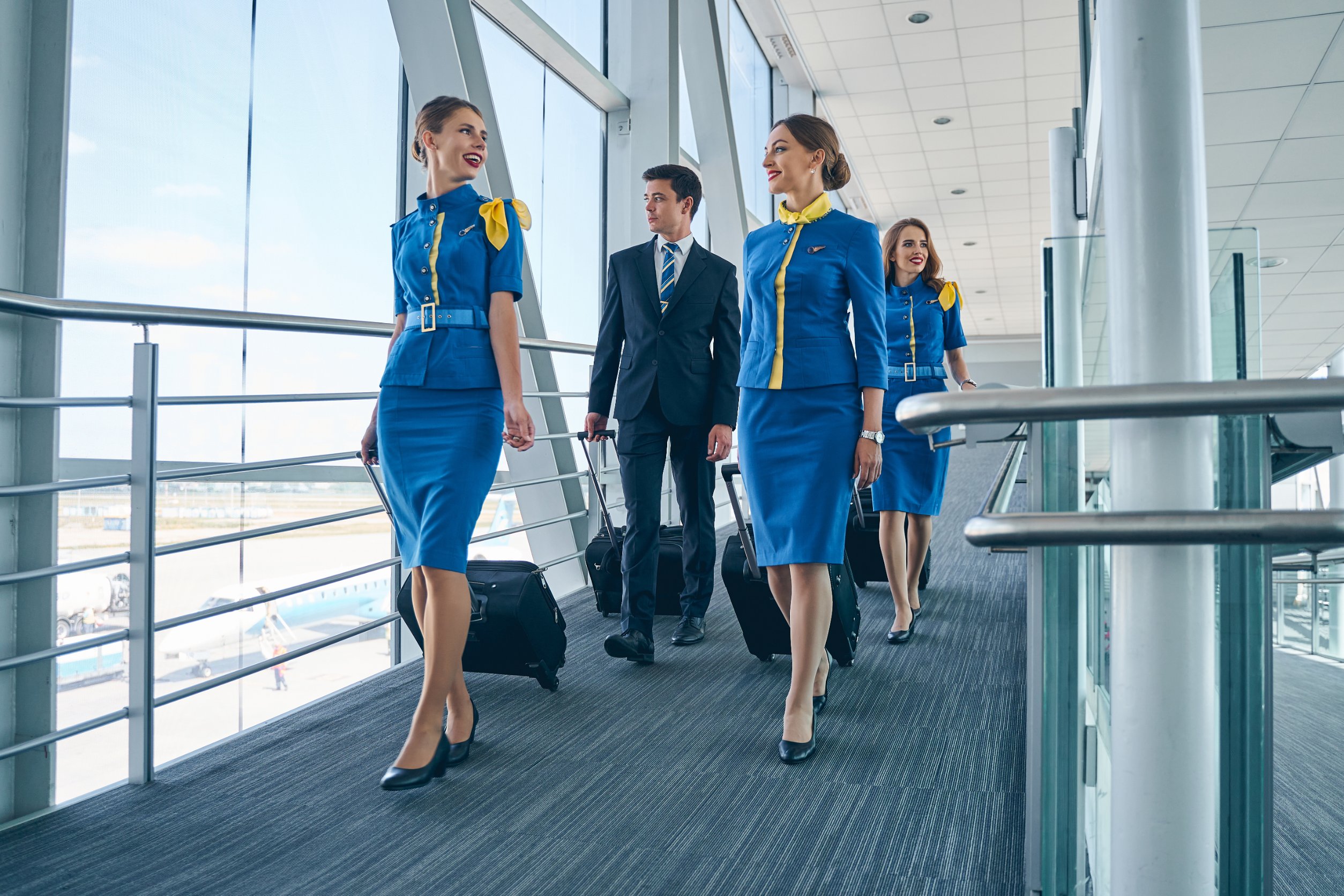Career Tips
Flight Attendant: What They Do And How To Become One

Aside from piloting and repairing planes, the airline and aircraft sectors offer a variety of jobs. If this sounds appealing to you, consider a job as a flight attendant, where you can give comfort and safety to all passengers. Understanding the daily responsibilities and job requirements may help you decide if this is the right career path for you.
In this article, we will look at what a flight attendant does, the average wage and job prospects, the prerequisites for becoming a flight attendant, their work environment, and an example of a job description.
What does a flight attendant do?
Flight attendants work for both private and commercial airlines to ensure passenger safety and comfort. They assist passengers with seating, show how to use the plane’s safety equipment, such as seat belts, and give snacks, beverages, and other amenities. Legally, all airlines must have flight attendants on staff to ensure passenger safety. Additional flight attendant duties include:
- Attending preflight briefings with the pilots to get flight information for each trip
- Inspecting emergency equipment before each flight
- Ensuring the plane’s cabin is clean and well-stocked with food and drinks
- Lifting heavy luggage into overhead bins and closing them before takeoff
- Making sure all passengers are prepared for takeoff and landing
- Helping passengers with special needs, small children or medical assistance needs
- Responding to disruptive passengers and monitoring the plane for suspicious behavior
- Helping passengers find their seats, locating and use safety equipment, putting out potential fires and directing evacuations in case of emergency situations
- Reporting safety or medical issues that occurred on a flight
- Reviewing company policies and health guidelines for passengers
Salary and job outlook for flight attendants
The national average annual income for a flight attendant is $39,321. Your earnings may vary depending on your experience, education, company, and region. Click on the following link to view the most recent Indeed salary information.
The US Bureau of Labor Statistics (BLS) predicts that flight attendant positions will increase by 21% between 2021 and 2031. This growth is substantially quicker than the average occupation. As a result, 18,100 job positions may become available each year.
Flight attendant requirements
To get hired as a flight attendant, you must be at least 18 or 21 years old, depending on the state or business, have a valid passport, have 20/40 vision, and pass a drug and background check. Additional qualifications may include passing a medical test and meeting the airline’s height standards.
Here are some other requirements to become a flight attendant:
Education
Flight attendants must have completed high school or have a GED. Some airlines may prefer an applicant who has an associate or bachelor’s degree in disciplines such as:
- Hospitality
- Public relations
- Tourism
- Communication
- Business
- Nursing
As an alternative, some people attend flight attendant school. If you want to work on international flights, you can consider taking foreign language classes.
- Training
Flight attendants may need a year or two to learn customer service. They receive three to six weeks, occasionally six months, of airline training after hiring. flying attendants study safety, emergency procedures, first aid, flying regulations, and job obligations throughout training. They practice their new abilities and knowledge on practice flights. This basic training is required for FAA certification for all flight attendants. This role may receive additional training from the airline.
- Certifications
Flight attendants require certification with one of the following credentials:
- FAA Certificate of Demonstrated Proficiency
This certificate, which flight attendants obtain after finishing their on-the-job training and passing a test, is required. Flight attendants train and obtain certification for each type of aircraft they operate on. They also receive annual training to maintain their certification.
- Flight Attendant Certificate Courses
Organizations such as the Inflight Institute provide certification programs based on the kind of airline: charter, regional, national, or international. Before being engaged by one of their partner airlines, flight attendants must complete flight attendant certificate classes that cover everything from aviation vocabulary to safety protocols to passenger management.
- Skills
Organizations such as the Inflight Institute provide certification programs based on the kind of airline: charter, regional, national, or international. Before being engaged by one of their partner airlines, flight attendants must complete flight attendant certificate classes that cover everything from aviation vocabulary to safety protocols to passenger management.
- Attention to detail: Flight attendants monitor passengers for issues or suspicious activities. They’re meticulous when doing safety checks on equipment and for people.
- Communication: Individuals in this role can communicate clearly and confidently when giving safety demonstrations and interacting with passengers and crew. They’re also courteous and have strong listening skills.
- Customer service: Part of a flight attendant’s job is providing hospitality, which can include answering questions, directing passengers to their seats and assisting with storing luggage in the overhead bins. They’re friendly and patient when providing services to ensure passengers have a positive flight.
- Stamina: Flight attendants often work long hours, respond to challenging passengers and handle heavy items, such as luggage and service carts.
- Efficiency: Flight attendants work quickly and efficiently to complete preflight tasks for an on-time departure.
- Leadership: In emergencies, flight attendants take charge and make quick decisions to guide passengers to safety.
How to become a flight attendant
Here’s an overview of how to become a flight attendant in ten steps:
- Get a high school diploma: The minimal educational requirement for flight attendants is a high school diploma or GED.
Talk to a career counselor: Speak with a counselor about your desire to become a flight attendant. Your career counselor can assist you in selecting the most appropriate coursework to prepare you for this profession.
Earn a college degree: While most airlines recruit flight attendants without a degree, an associate or bachelor’s degree in public relations may increase your job prospects.
- Build customer service skills: Consider working for a year or two in a hospitality or service position to hone your customer service skills. You may work at a restaurant, a hotel, or any other position that demands interaction with others.
- Practice your interview skills: Demonstrate your knowledge of flight attendant duties and skills, as well as your ability to provide excellent customer service. Prepare a résumé in advance to demonstrate your educational background and customer service experience.
- Apply for jobs: You can apply for flight attendant positions if you’re over 18 years old and have good health and vision.
- Train: If an airline hires you, you can train for weeks or months to become FAA certified. Training classes cover first aid, responding to difficult flight or passenger circumstances, evacuating, extinguishing fires, and learning survival and self-defense techniques.
- Get certified: After you have completed initial training, pass the FAA’s exam to become certified and legally allowed to work as a flight attendant.
- Complete reserve status: New flight attendants begin on reserve status. During this time, you are on call to fill in for other flight attendants or extra flights, which normally lasts one year.
- Advance in your career: After gaining enough experience, you may acquire the authority to select your base, routes, and schedule. You may also mentor, recruit, train, or manage other flight attendants and assist with activities such as scheduling.
Work environment for flight attendants
Flight attendants work part-time or full-time for commercial, corporate, regional, or international airlines. Because airlines function 24/7, including holidays and weekends, they work long hours and on-call or last-minute shifts. Most airlines limit flight attendants to 12 hours a day, but foreign flights may demand more. Flight attendants must have nine hours off between shifts per FAA regulation.
Hotel stays between flights can keep them away for days. Flight attendants work in the air and on the ground preparing for the next flight. They work in the plane’s cabin alongside crew. Flight attendants must handle crises, air turbulence, and long periods on their feet.
Flight attendant job description example
Here’s an example of a job description for a flight attendant:
Hero Airlines is seeking an experienced flight attendant to join our enthusiastic flight crew. The flight attendant’s general duties involve routine safety checks and passenger assistance as they ensure every client has a comfortable and first-rate flying experience.
We’re looking for an individual with exceptional customer service, a love of travel and the ability to maintain a flexible schedule and work on short notice. The ideal candidate also has excellent communication skills and makes effective decisions in a fast-paced environment. Candidates have at least three years of experience and receive on-job training upon being hired.
Source: indeed












